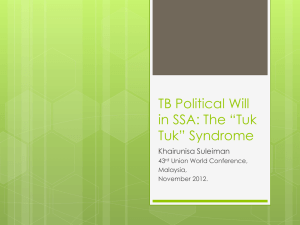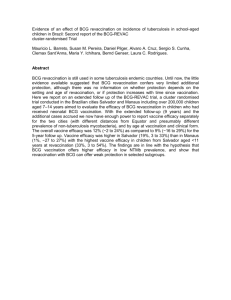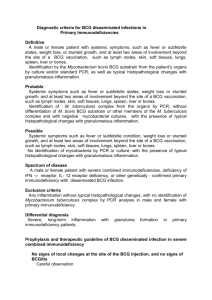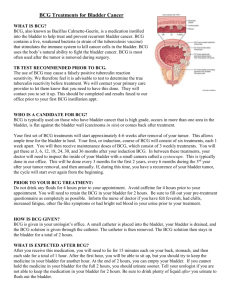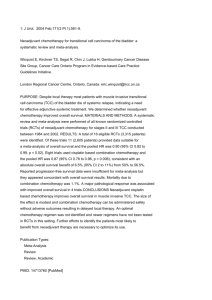st. tammany parish hospital department of nursing
advertisement
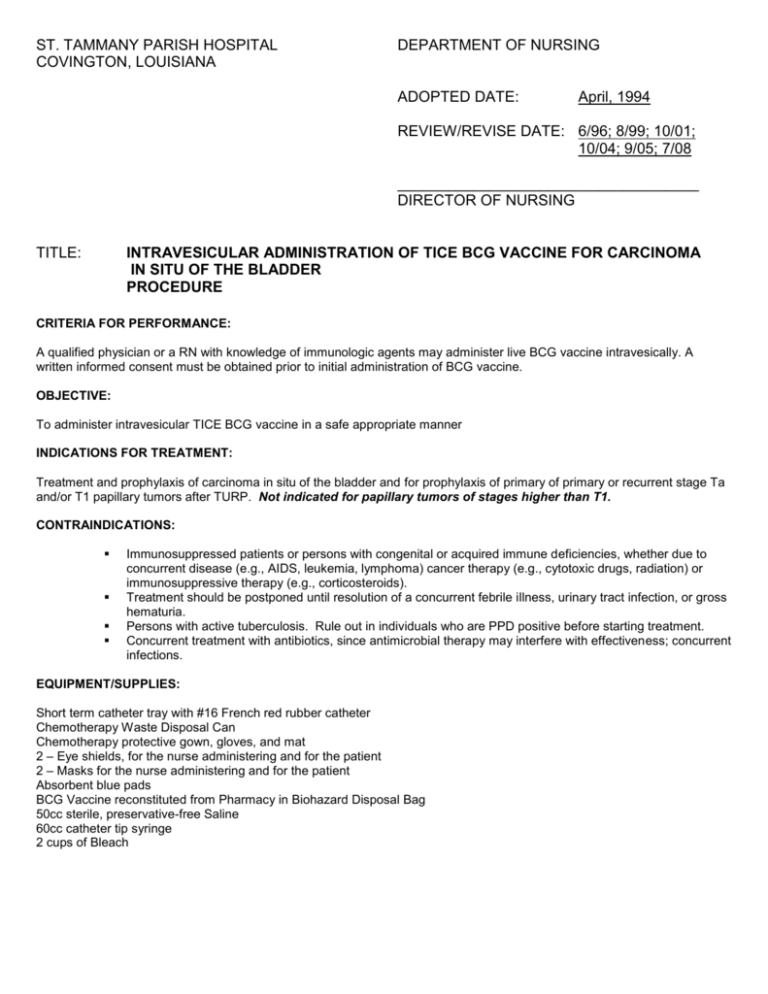
ST. TAMMANY PARISH HOSPITAL COVINGTON, LOUISIANA DEPARTMENT OF NURSING ADOPTED DATE: April, 1994 REVIEW/REVISE DATE: 6/96; 8/99; 10/01; 10/04; 9/05; 7/08 ____________________________________ DIRECTOR OF NURSING TITLE: INTRAVESICULAR ADMINISTRATION OF TICE BCG VACCINE FOR CARCINOMA IN SITU OF THE BLADDER PROCEDURE CRITERIA FOR PERFORMANCE: A qualified physician or a RN with knowledge of immunologic agents may administer live BCG vaccine intravesically. A written informed consent must be obtained prior to initial administration of BCG vaccine. OBJECTIVE: To administer intravesicular TICE BCG vaccine in a safe appropriate manner INDICATIONS FOR TREATMENT: Treatment and prophylaxis of carcinoma in situ of the bladder and for prophylaxis of primary of primary or recurrent stage Ta and/or T1 papillary tumors after TURP. Not indicated for papillary tumors of stages higher than T1. CONTRAINDICATIONS: Immunosuppressed patients or persons with congenital or acquired immune deficiencies, whether due to concurrent disease (e.g., AIDS, leukemia, lymphoma) cancer therapy (e.g., cytotoxic drugs, radiation) or immunosuppressive therapy (e.g., corticosteroids). Treatment should be postponed until resolution of a concurrent febrile illness, urinary tract infection, or gross hematuria. Persons with active tuberculosis. Rule out in individuals who are PPD positive before starting treatment. Concurrent treatment with antibiotics, since antimicrobial therapy may interfere with effectiveness; concurrent infections. EQUIPMENT/SUPPLIES: Short term catheter tray with #16 French red rubber catheter Chemotherapy Waste Disposal Can Chemotherapy protective gown, gloves, and mat 2 – Eye shields, for the nurse administering and for the patient 2 – Masks for the nurse administering and for the patient Absorbent blue pads BCG Vaccine reconstituted from Pharmacy in Biohazard Disposal Bag 50cc sterile, preservative-free Saline 60cc catheter tip syringe 2 cups of Bleach PROCEDURE: NURSING ACTION 1. Wash hands 2. Place patient in private room with no other patients. Get baseline set of vital signs. Assess for the presence/absence of fever or urinary tract infections. 3. Verify results of urinalysis done pre-treatment. Call results to physician treating patients. 4. Have the patient urinate before treatment begins if possible 5. Place blue pad under patient on the bed to decrease the chance of linen contamination 6. Have patient lie supine in bed. Using sterile catheterization procedures, drape and catheterize the patient with a short term catheterization tray and a #16 French red rubber catheter. 7. Empty the bladder of any residual urine. 8. Don chemotherapy administration protective gown and gloves. In addition, don a face mask and eye shield. Have Chemotherapy Waste Disposal Can in room. 9. The patient should don a mask and eye shield during the instillation of solution and then they may be removed. 1. To decrease unwanted exposure of other patients, including chemotherapy patients. 3. Patient should not receive BCG if symptoms of UTI, elevated WBC, or blood in urine are evident since it can promote a systemic BCG infection. 6. Every effort should be made to make the catheterization non-traumataic. 7. To enable the patient to hold the bladder instillation the required 1 – 2 hours. 8. To decrease possibility of exposure to live BCG Vaccine during instillation. Gown, gloves, and mask may be removed after administration, but should be used in cleaning up after procedure also. 9. To decrease possibility of exposure to live BCG Vaccine. 10. Draw up 40cc of preservative-free Normal Saline into a 60cc catheter tip syringe. Using chemotherapy absorbent mat, dispense the cloudy BCG suspension into the end of the catheter tip syringe containing 40cc of preservative-free Normal Saline 11. Place empty BCG syringe in Chemotherapy Waste Can and close lid. 12. Attach the 60cc syringe to the catheter and gently remove the plunger. 13. The reconstituted TICE BCG should be allowed to enter the bladder by gravity flow over 3 – 4 minutes. 14. Once the instillation is completed, withdraw the catheter into an absorbent blue bad to catch any droplets that may exit the catheter tip. 15. The patient should lay prone for 15 minutes, supine for 15 minutes, right lateral position for 15 minutes, then left lateral position for 15 minutes for the first hour. The patient should hold the solution in the bladder for at least 1 hour, preferably up to 2 hours. 16. The nurse should stay with the patient the first 15 minutes, then check on the patient every 15 minutes x 3 to remind the patient to turn, then check every ½ hour x 2. 17. At the completion of the instillation, the patient should be instructed to void in a sitting position in a commode where 2 cups of bleach has been added before voiding. The toilet should not be flushed for 15 minutes. 10. Gently swirl the syringe to mix after adding TICE BCG Vaccine. The reconstituted TICE BCG must be used immediately. 18. All chemotherapy equipment and blue pads should be placed in the Chemotherapy Disposal Can. Housekeeping should be called to remove the hazardous waste disposal. 19. Linen and gowns may be handled in routine fashion. The room and bathroom are cleaned with disinfectant in the routine fashion. 18. Containers should not be reused for other chemotherapeutic waste. Goggles may be cleaned with 70% Isopropyl Alcohol solution using a disposal towel. 11. Decrease possibility of room contamination. 12. DO NOT DEPRESS THE PLUNGER AND FORCE THE FLOW TO THE TICE BCG. 14. Discard immediately into the Chemotherapy Disposal Can and snap lid. 15. Turning ensures that all bladder surfaces are coated with the solution. The solution should be held for up to 2 hours to maximize bladder wall contact and drainage effectiveness. 16. To monitor for possible local or systemic reactions. 17. Bleach kills the TICE BCG live vaccine. Allowing the bleach to sit for 15 minutes allows time for the live virus to die. Adding bleach BEFORE the patient voids minimizes contaminated urine splashing on or outside the commode. 20. The patient should be instructed to: a. Use 2 cups of bleach in the commode with each voiding for 6 hours after completion of treatment. Wait 15 minutes after voiding before flushing. Wash hands well after each voiding. a. Force fluids for 3-4 days after treatment (8-12 glasses of fluid/day) to flush out bladder. b. Burning and frequent urination for the first day or two after instillation is normal. Slight flu-like symptoms are also possible. d. If the patient experiences severe urinary side effects – blood in the urine, a fever of 103 degrees or greater and/or flu-like symptoms that last more than 48 hours – the patient should contact the treating urologist immediately. 21. Discharge vital signs, tolerance of treatment, and patient understanding of discharge instructions should be recorded. 20. Most reactions that are seen with BCG Vaccine are local versus systemic and results from irritation to the bladder wall. Forcing fluids will keep the patient voiding frequently, decreasing the chance of bladder irritation, bleeding, or urinary tract infections. The patient should understand that if any symptoms of UTI persist or become worse or if flu-like symptoms are present, the physician needs to be notified at once. Provide patient Micromedex patient information on medication before discharge. RELATED STANDARDS: Foley Catherization Procedure Chemotherapy Safety Management Protocol REFERENCES: Manufacturer’s Drug Insert – TICE BCG Vaccine, Organon Teknika Corporation, Dec. 2006. Drug Information: Bacillus Calmette-Guerin (BCG) vaccine. Medline Plus website: www.nlm.nih.gov/medlineplus DISTRIBUTION: Infusion Suite; Medical Oncology Unit K:\Oncology\CHEMO Protocols\procedures\tice bcg adm procedure.doc
